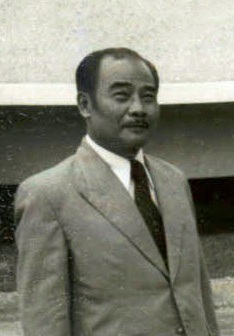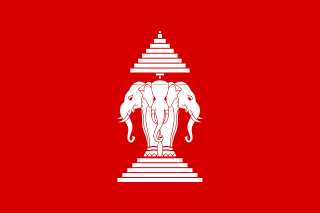
Laos, officially the Lao People's Democratic Republic, is the only landlocked country in Southeast Asia. At the heart of the Indochinese Peninsula, Laos is bordered by Myanmar and China to the northwest, Vietnam to the east, Cambodia to the southeast, and Thailand to the west and southwest. Its capital and largest city is Vientiane.

The politics of the Lao People's Democratic Republic takes place in the framework of a one-party parliamentary socialist republic. The only legal political party is the Lao People's Revolutionary Party (LPRP). The head of state is President Thongloun Sisoulith, who is also the LPRP general secretary, making him the supreme leader of Laos. The head of government is Prime Minister Sonexay Siphandone.

Kaysone Phomvihane was the first leader of the Communist Lao People's Revolutionary Party from 1955 until his death in 1992. After the Communists seized power in the wake of the Laotian Civil War, he was the de facto leader of Laos from 1975 until his death. He served as the first Prime Minister of the Lao People's Democratic Republic from 1975 to 1991 and then as the second President from 1991 to 1992.

Prince Souphanouvong, nicknamed the Red Prince, was along with his half-brother Prince Souvanna Phouma and Prince Boun Oum of Champasak, one of the "Three Princes" who represented respectively the communist (pro-Vietnam), neutralist and royalist political factions in Laos. He was the President of Laos from December 1975 to October 1986.

Nouhak Phoumsavanh or Phoumsavan was a longtime Pathet Lao revolutionary and communist party official who was the 3rd President of Laos from 1992 to 1998.

Laos elects a legislature nationally and the public also participates in the election of village heads. The National Assembly has 164 members, elected for five year terms.

The president of the Lao People's Democratic Republic is the head of state of Laos. The current president is Thongloun Sisoulith, since 22 March 2021. He was previously elected as the General Secretary of the Lao People's Revolutionary Party, Laos' most powerful position in January 2021, ranking him first in the Politburo.

The Prime Minister of the Lao People's Democratic Republic, formerly the chairman of the Council of Government of the Lao People's Democratic Republic, is the head of government of Laos. The highest position in the government, they direct the country's executive branch. The prime minister is accountable to the president, the National Assembly and the country's only legal party: the Lao People's Revolutionary Party (LPRP). The current prime minister is Sonexay Siphandone, who was elected in 2022.

The National Assembly is the highest power organisation of Laos. It is the only branch of government in Laos, and per the principle of unified power, all state organs are subservient to it. The National Assembly meets in Vientiane.

Thongloun Sisoulith is a Lao historian and politician serving as General Secretary of the Lao People's Revolutionary Party since 15 January 2021 and President of Laos since 22 March 2021.

The Royal Lao Government in Exile (RLGE) is a Laotian government in exile opposed to the Lao People's Democratic Republic established on May 6, 2003, and seeks to reinstall a constitutional monarchy in Laos. The RLGE also seeks to end what it sees as the Vietnamization of Laos and the Lao-Viet special Brotherhood Treaty. It was most recently headed by then Prime-minister Khamphoui Sisavatdy and King Soulivong Savang.

The following outline is provided as an overview of and topical guide to Laos:

The Constitution of Laos specifies the functions and powers of the government of the Lao People's Democratic Republic, and defines the rights and duties of Laotian citizens. The constitution was adopted on August 14, 1991, sixteen years after the 1975 establishment of the Republic, a period during which the country functioned without a written constitution or published penal and criminal codes. It consists of a Preamble and Articles, and legally establishes a set of authorities that resemble the traditional differentiation among executive, legislative, and judicial branches of government.

Thongsing Thammavong is a Laotian politician who was the Prime Minister of Laos from 2010 to 2016. He is a member of the Lao People's Revolutionary Party (LPRP) and has been a member of the LPRP Politburo since 1991. He currently serves in the National Assembly of Laos, representing Luang Prabang Province, and was the President of the National Assembly from 2006 to 2010. He became Prime Minister on 23 December 2010, and left office on 20 April 2016.

Laotian women have long been active participants in their nation's society, involved in politics, driving social transformation and development, becoming active in the world of business and serving as nurses and food producers for the military. Due to modernization and rural uprooting, Lao women have begun to embrace lifestyles that are foreign to traditional Laotian ideals.

Democratic centralism is the organisational principle of communist states and of most communist parties to reach dictatorship of the proletariat. In practice, democratic centralism means that political decisions reached by voting processes are binding upon all members of the political party. It is mainly associated with Leninism, wherein the party's political vanguard of revolutionaries practice democratic centralism to select leaders and officers, determine policy, and execute it.
The following lists events that happened during 2017 in Laos.

The Parliament of the Kingdom of Laos was the bicameral legislature of the Kingdom of Laos from 1947 to 1975. It consisted of the National Assembly, whose members were popularly elected, and the Royal Council, whose members were appointed by the King or elected by the National Assembly. The last elections to the National Assembly took place in 1972.

The 1st Supreme People's Assembly of Laos was elected by the National Congress of People's Representatives on 2 December 1975. It was replaced by the 2nd Supreme People's Assembly on 1 June 1989.


















